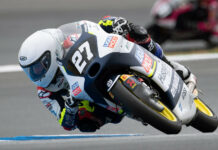By John Ulrich I’ve been in this business a long time. I sold my first article to a magazine in 1972, started road racing in 1973, wrote the proposal to establish the Superbike class that Steve McLaughlin and Hurley Wilvert successfully submitted to the AMA in 1975 and graduated from college with a degree in journalism in 1976. About a decade ago when I started talking about the need for AMA Pro Racing to deploy a fleet of inflatable soft barriers to improve rider safety, the then-current regime issued a press release basically saying it couldn’t possibly be done. I wouldn’t take no for an answer and started raising money. Five weeks later there were 20 30-foot sections of soft barriers deployed at Road Atlanta for an AMA Pro National. Two weeks after that there were 35 30-foot sections at Road America and we haven’t looked back. The not-for-profit Roadracing World Action Fund I founded has provided every section of Airfence that AMA Pro Racing currently deploys at its road races. I supported the sale of AMA Pro Racing to the professionals at Daytona Motorsports Group (DMG) because AMA had proven time and time again, through regime change after regime change, that it couldn’t run professional racing fairly and couldn’t stop its for-profit racing subsidiary from being a serious financial drain on the association. And nobody has spent more time and energy trying to help DMG get it right since the sale. I want AMA Pro Racing to succeed under DMG management. Last year, when I was defending AMA Pro Racing after researching the debacle involving the cancellation of the race at VIR””a situation that was 100% created by track management, which then falsely laid blame on AMA Pro Racing””DMG Managing Member David Atlas told a riders meeting that anybody who wanted to know what really caused the cancellation, should read what I had written and posted on roadracingworld.com. He told people that I carefully checked facts and that I am an accurate reporter. DMG partners and AMA Pro employees alike thanked me for reporting the truth about what had happened. But when the news is bad, when AMA Pro Racing is really screwing up, the same people don’t want to hear it and don’t even want to discuss it in a meeting. The same partners and employees who loved me last summer now piss and moan and send out their anonymous surrogates to claim I am not accurate nor factual and cannot be believed, that I have too much influence and that I’m disgruntled and have ulterior motives and a personal grudge and that there’s no way DMG would impose the draconian penalties it now has on the books regarding patch placement and displaying AMA Pro Racing trademarks at non-AMA Pro events. In fact, I’m not doing anything different now when the DMG-ites are in an uproar, than what I was doing last summer when the DMG-ites were singing my praises. Truth stands on its own, and the truth is that DMG is seriously screwing up by heading down a very slippery slope. On the course it’s currently taking, AMA Pro Racing under DMG management is headed directly into a cesspool of commercial corruption and is doomed to spectacular failure. Too much influence? Why haven’t I been able to get a meeting with the assembled DMG partners despite six months of trying? Why do I want to meet with the DMG partners? Because what I’ve learned in multiple meetings with David Atlas is that all a meeting with Atlas gets is vague promises of “very careful consideration” and invitations to more time-wasting meetings. It’s obvious, based on what Atlas says, that he is not in charge. The way he tells it, it isn’t even his fault when he says the organization is going to do one thing and it instead does the opposite, because he isn’t able to control or even keep track of what his employees are doing. DMG won’t bust anybody for wearing leathers or riding a bike that displays the AMA Pro Racing logo at non-AMA Pro events? Hey, if somebody had told me in June 2009 that the timing and scoring crew was vindictively targeting specific riders for unjustified ride-through penalties, I wouldn’t have believed it””there’s no way the DMG professionals would allow something like that to happen! In fact, I didn’t believe it until 2009 Race Director Colin Fraser””a guy I admired and had raced with in the 1980s””and David Atlas himself confirmed that indeed, that’s exactly what had been going on! If you think it doesn’t matter, go talk to the rider who got six bogus ride-through penalties during the 2009 season, not because he had reported when the timing and scoring systems didn’t work, but because he was associated with somebody who reported when the timing and scoring systems didn’t work! Or ask Geoff May, or Neil Hodgson, or Taylor Knapp, or Ben Bostrom, or Josh Hayes, or Aaron Yates or any of the other riders snagged in the net of corruption. And where did this piece of rulebook language threatening draconian penalties for displaying the AMA Pro Racing logo at non-AMA Pro events come from, anyway? When was it enacted, and who got to comment on it? (The DMG attempt to restrict display of the AMA Pro Racing logo runs counter to the wildly successful experience of Monster Energy, which has reported significant increases in revenue and profits throughout the recession. The company’s marketing program is centered around trying to get the Monster “M” logo to show up on as many people and at as many places as possible. Nobody from Monster Energy is threatening riders who show up at track days with giant Monster logos on their bikes!) Above all, a racing organization has a responsibility to follow its own rules and to enforce its rules fairly and equally, no matter who is involved in any given situation. The fairness and professionalism of a racing organization can best be judged by how its officials deal with and treat competitors and other participants they don’t like and don’t agree with. It is a bedrock principal worth repeating: AMA Pro Racing has a responsibility to follow its own rules and to enforce its rules fairly and equally, no matter who is involved in any given situation. By the middle of the 2009 season it was obvious to me that the people running AMA Pro Racing for DMG at the time””especially AMA Pro President Roger Edmondson””were ignoring their own rules as well as any sense of common decency or fairness. Examples are easy to remember: One of the two biggest examples involved the commercially driven homologation of a Superbike that clearly was not based on a production motorcycle, in direct violation of the rulebook. The other, which affected more people, involved the ride-through-penalties assessed against targeted riders for bogus jump starts based on incidental, ephemeral movement that could only be seen using frame-by-frame examination of grid-camera video . After a discussion, Edmondson told me that he would end the nonsensical ride-through penalties being handed out even if bikes were perfectly stationary when the starting lights went out and it was clear that no advantage was gained. Instead, nothing changed, and I realized that just because Edmondson said he would do something, did not mean he actually would do something. At that point I had lost all faith in him and knew something had to change. Fortunately for us all, something did change, with David Atlas replacing Roger Edmondson as the man nominally in charge of AMA Pro Racing. Things were looking up in 2010 and 2011, other than for a few problems involving various rules, like the one requiring riders to earn 100 points to advance from SportBike to Superbike. One rider competed in every race during the 2009 Daytona SportBike season without scoring a single point, yet was issued a 2010 Superbike license. Why? Because if the rider didn’t get a Superbike license, his team owner said he would take his semi-truck and go home. Call it a victory for commercial considerations prevailing over the rulebook. It got worse. A rider who raced as a WSMC Novice in April 2010 but was a principal in a new Superbike team was issued a 2011 Superbike license. He made it a few laps into the first Superbike practice session during the season opener at Daytona, then crashed in the chicane and broke his neck, among other things. Call it another victory for commercial considerations prevailing over the rulebook. This got my attention. Meetings were held. Atlas told me that the AMA Pro licensing rules would be followed. But between the time he said that and the time the series arrived at Infineon Raceway for the second round of the season, Superbike licenses had been issued to more riders who were not qualified under the rules. One had raced in the SuperSport class in 2010 and had earned 18 SportBike points at Daytona 2011 before he was handed a Superbike license; in the span of three laps at Infineon, he was directly involved in two incidents that resulted in four riders crashing, including himself. All of the newly minted Superbike stars crashed during their first weekend with a Superbike license. When I asked Atlas why the SuperSport kid with 18 SportBike points had been issued a Superbike license, he told me that the kid was a future superstar and that AMA Pro had to issue him a license to keep the manufacturer he rode for on the grid. Atlas and his DMG associates have not explained why another kid with roughly equivalent experience was denied a Superbike license in 2010, other than, he didn’t ride for the right, manufacturer-backed team. Score yet another victory for commercial considerations””plus some star power–prevailing over the rulebook. (Recently, Atlas said that he was not able to keep track of what his employees were doing and didn’t know that they had continued to issue Superbike licenses to unqualified riders after he had said the practice would stop. Adding a sense of futility is the fact that the involved manufacturer quit the series anyway.) Ignoring your own rules on a selective basis for commercial purposes is bad enough. But tailoring rules to meet the demands of a single manufacturer-backed team is far, far worse. Which brings us to the slippery slope AMA Pro Racing under DMG management is now headed down at full throttle. Many racing organizations are looking at ways to control costs and reduce the reliance on advanced electronic controls. British Superbike is using a spec ECU now. MotoGP has announced plans to implement a spec ECU for the 2013 season. (It’s easy to understand why. Advanced electronics do nothing to enhance the visceral appeal of racing, instead working to keep the wheels in line and on the ground while reducing slides and wheelies. Advanced electronics do nothing to enhance the visual, “bling” appeal of racing, because they’re tucked up underneath the bodywork where the plain box they reside in can’t be seen. And if nobody had advanced electronics, nobody would need them. But because some teams have advanced electronics, every team that wants a consistent chance to win has to have advanced electronics. But more than anything, buying, installing, maintaining and crewing advanced electronics hardware and the software needed to make it work is very expensive. Yoshimura R&D, for example, recently told Roadracing World that it spends $300,000 a year on electronics for two riders. That $300,000 could have gone a long way toward keeping Tommy Hayden on the team for 2012.) AMA Pro Racing, meanwhile, ran a web-based survey and held meetings with team principals to discuss the electronics situation. The vast majority of teams””even two out of the three Superbike teams that actually ran very advanced electronics during the 2011 season””wanted meaningful, serious cutbacks in the electronic systems allowed on AMA Pro Superbikes. The majority of teams wanted to use readily-available race-kit boxes and add-ons with retail pricing that started around $2400 per bike. What the DMG professionals running AMA Pro Racing came up with after months of dithering was an $18,000 per bike hardware price cap, with no limit on software or the cost of personnel to run the finicky systems. Within days of that announcement, suppliers of electronic systems were calling teams to report that they would beat the cap by reducing the list price of the hardware and increasing the list price of the software. Which means that the price cap accomplished nothing. Why did AMA Pro Racing announce the new $18,000 per bike ($36,000 for the primary and spare bikes needed by each rider) hardware cap running from the start of 2013 through 2015? I ran into a guy who runs one of the most successful teams in AMA Pro Superbike history, a team that runs advanced electronic controls, during an industry show held in Indy last month. He had just spoken to David Atlas and his entourage about the situation, and was in a state of shock. The way he told it, a member of the AMA Pro group said, “We had to set the cap that high, because (insert the name of the single team that didn’t want to give up its pricey electronics) said they’d quit the series if we didn’t. What else could we do?” I wasn’t surprised, because Atlas had told me the same thing. “My hands are tied,” Atlas said to me. “I can’t afford to have them leave the series.” So that’s where AMA Pro Racing version DMG is now: Openly tailoring technical rules to suit a single manufacturer-based team that threatened to quit if it didn’t get its way–and admitting as much to other front-line teams. Pandering to a single team and making rules based on blackmail doesn’t have anything to do with responsibility or fairness or equal treatment of participants. It is bad policy, the ultimate victory of commercial considerations over objective rule making, and a guaranteed road to ruin. But there is a solution. More to follow”¦
FIRST PERSON/OPINION: AMA Pro Racing At A Crossroads, Part 3
FIRST PERSON/OPINION: AMA Pro Racing At A Crossroads, Part 3
© 2012, Roadracing World Publishing, Inc.






